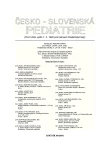Prediction and Prevention of Type 1 Diabetes Mellitus
Authors:
J. Vavřinec; O. Cinek; S. Koloušková; Z. Šumník; M. Šnajderová; P. Mendlová; K. Sekerášová
Authors‘ workplace:
Pediatrická klinika 2. LF UK a FN Motol, Praha
přednosta prof. MUDr. J. Vavřinec, DrSc.
Published in:
Čes-slov Pediat 2005; 60 (6): 314-323.
Category:
Original Papers
Overview
The incidence of type 1 diabetes (DM1) in children varies between continents and countries.
The precise mapping of DM1 incidence and its trends helps to investigate interactions of genetic and non-genetic factors at a population level.
Authors evaluated total, age-specific and sex-specific incidence rates of DM1 and their trends in Czech children at 0–14 years of age in the period of 1989–2003. Diabetic children were ascertained by two independent sources: the Czech Childhood Diabetes Registry Network and the database of “Association of Parents and Friends of Diabetic Children”. Denominator data on general population size were obtained from the Czech Statistic Bureau annual reports.
In the period 1st January 1989–31st December 2003 the standardised incidence was 12.0 (CI 95% 11.6–12.4)/100 000/year. The total incidence has an increasing trend over this period (annual increment 6.8%). Significant male predominance was observed in the group diagnosed at the age of 0–4 years (boys/girls ratio of incidence 1.19; p = 0.023), female predominance in the group 5–9 years (boys/girls ratio of incidence 0.88; p = 0,021). Total prevalence of DM1 was 1.02/1000 (CI 95% 0.96–1.06).
The level of DM1 conferred by the HLA class II genes also varies between nations and ethnic groups. Authors investigated the role of HLA-DQB1,-DQA1 genes, DRB1* subtypes and insulin gene polymorphism in diabetic population. Authors present IDDM1 and IDDM2 gene polymorphism association of DM1 in the Czech population.
Clinical studies for primary and secondary DM1 prevention were introduced in first-degree relatives of diabetic patients. The rationale for TRIGR (Trial to Reduce IDDM in the Genetically at Risk) began with observational studies that showed that breastfeeding was associated with somewhat lower rates of children developing DM1. The TRIGR trial will determine whether delayed exposure to intact food proteins will reduce the changes of developing DM1 later in life.
All babies in the study receive the recommendation to breastfeed for at least the first six months of life. If a mother is unable to exclusively breastfeed before the baby is 8 months of age, her child will be randomly assigned to one of two groups. One group of these babies will receive breastfeeding supplements of a trial formula based on extensively hydrolysed protein; the other group will receive a special trial formula containing a smaller amount of hydrolysed protein. In hydrolysed protein, the big protein molecules have been split into very small fragments to provide a source of nutritional amino acids, but the fragments are likely too small to stimulate the immune system.
Key words:
type 1 diabetes mellitus, incidence and prevalence, primary and secondary prevention, TRIGR
Labels
Neonatology Paediatrics General practitioner for children and adolescentsArticle was published in
Czech-Slovak Pediatrics

2005 Issue 6
Most read in this issue
- Relation of Sexual and Skeletal Maturity Assessment to Biological Age in Pediatric Practice
- Growth and Final Height in Girls with Central Precocious Puberty after Long-term Treatment with Depot Gonadoliberin Analogue
- Prediction and Prevention of Type 1 Diabetes Mellitus
- Homozygous Form of Familial Defect of Apo B-100 (FDB) in a 7-Year Girl
